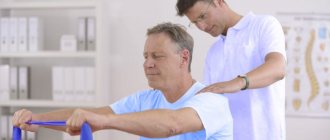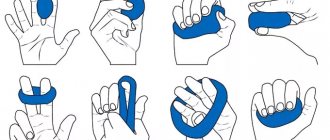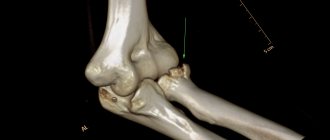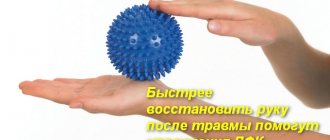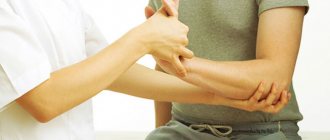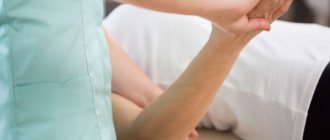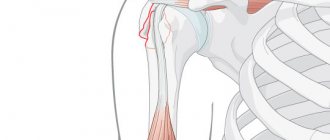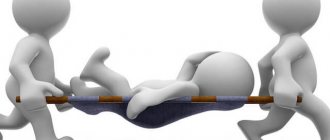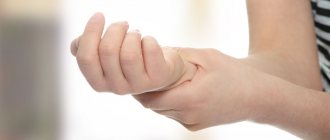A significant portion of household injuries are fractures of the upper and lower extremities. When falling with emphasis on the arm, a fracture of the radius often occurs, in which the patient has to be placed in a plaster cast. The hand remains in a fixed state for a month or more, and forced immobility leads to atrophic phenomena in muscle and connective tissue, disruption of vascular tone and nerve conduction. To restore hand function, a set of measures is carried out, including a special massage after a fracture of the radius.
Why is massage performed after a fracture of the radius?
After the cast is removed, the injured arm sometimes still hurts. It is necessary to restore joint mobility; in some cases there is residual swelling and cyanosis of the skin. Measures are needed to improve blood circulation in the limb, improve lymphatic drainage, and eliminate congestion. Massage helps with this.
Moderate physical impact during a massage restores blood flow, accelerates the restoration of nerve fiber conductivity, and eliminates spasm of blood vessels and muscles. The tissues receive the necessary nutrients, metabolic products are removed from the source of inflammation, swelling decreases, and muscle tension is relieved. This leads to a decrease in pain, increased joint mobility, improved nutrition and tissue regeneration.
Numbness of the fingers after a wrist fracture
Constant or periodic numbness of the fingers after a fracture of the wrist joint indicates that during the healing of the damaged bone tissue, the nerve fiber was pinched in one of the three canals.
The wrist joint is complex in its anatomical structure. It includes the epiphyses of four bones: the radius, scaphoid, lunate and triquetrum. Between them there are three channels in which nerves and blood vessels pass:
- cubital canal - here passes the ulnar nerve and blood vessels from the groove of the ulna;
- radial canal - the radial flexor tendon passes through and the radial artery, which is responsible for the blood supply to the soft tissues of the hand, is based here;
- carpal tunnel - in two synovial sheaths the median nerve and the artery supplying it with blood are located.
Numbness may be due to the fact that scar tissue has formed in one of the canals or calcium salts have been deposited while wearing a cast. Thus, with compression of the nerve fiber, innervation numbness of the fingers occurs. If all five fingers go numb, then most likely this is due to a violation of the blood supply. In any case, numbness in the fingers after a fracture of the wrist joint requires a long course of recovery.
Massage technique
A restorative hand massage begins with kneading the muscles of the shoulder girdle. Next they move to the area of the elbow joint, massage the muscles and the joint itself well. Move to the forearm, carefully massage the area around the fracture site. They switch to the hand area and knead the joints, develop the muscles, and activate the mobility of the fingers.
During a massage after a fracture of the radius bone of the arm, the sequence of classical massage techniques is followed:
- stroking;
- trituration;
- kneading;
- vibration.
The movements are at first smooth, of low intensity, then their amplitude and strength increase. The direction of movement is along and across the line of the forearm and around the fracture site. Particular care is required when massaging the fracture site and nearby tissues. Moderate, careful circular movements with the pads of the thumbs are recommended here.
The following massage techniques are used on the forearm area:
- grasping strokes;
- circular stroking on the lateral surfaces;
- cross rubbing with the ribs of the palms;
- circular kneading movements with fingertips;
- rubbing by sliding along the lateral surfaces;
- two-handed forceps-like kneading of muscles.
Each massage session lasts approximately 10-20 seconds. Between techniques, several soft relaxing strokes are performed along the forearm. The massage at each area ends with fading stroking.
Duration of procedures
With a simple fracture without significant complications, the rehabilitation period of the limb will last approximately 1-1.5 months. And in the presence of contracture, the recovery period lasts up to six months.
The total duration of the massage session is 15 minutes, it is recommended to do it every day or every other day. The number of sessions depends on the complexity of the condition and is determined by the traumatologist
Features of the procedure for different types of fractures
Massage of the arm after a fracture of the radius should be carried out by a massage therapist, as it is necessary to follow a certain technique. Inept massage can cause harm to the affected limb.
Any massage should begin and end with stroking. The massage technique depends on the location and severity of the fracture, including whether there is displacement of bone fragments or not. Special efforts by a specialist will be required if, after removing the plaster, stiffness or immobility of the joint is observed.
The specialist applies the necessary massage technique, taking into account the complexity of the particular case. It’s one thing if you just need to develop muscles that have atrophied under plaster, another thing is to restore reduced conductivity of the nerve trunk and develop non-functioning fingers and joints.
Working on the hand requires great skill of a specialist, knowledge of anatomy and physiology. If there is joint contracture, then in addition to the usual measures to develop the joint and muscles, they improve the conductive function of the nerve fiber. The massage includes special stimulating pressure along the nerves and includes targeted physiotherapy.
Additional measures
There are other methods of therapy that are usually supplemented with exercises for the arm after a fracture of the radius. Thus, thermal procedures are important during the recovery process. Warming up can be done in various ways, but the temperature should not be more than 39-40 degrees Celsius. This can be done at home too. It is enough to fill a one-liter plastic bottle with water, take it in your healthy hand and gently roll it along the affected forearm. Perform similar movements for the front and back surfaces and repeat until the water in the bottle is at a temperature close to body temperature.
If possible, it is recommended to add massage to the exercises of the affected limb.
Physiotherapy can significantly alleviate the unpleasant symptoms of injury. The doctor may prescribe the following procedures:
- Exposure to ultra-high frequency magnetic field. The procedure promotes tissue heating, which accelerates regeneration and helps relieve pain.
- Exposure to low frequency electromagnetic field. As a result of the procedure, swelling subsides and discomfort becomes less severe.
- Irradiation of the fracture site with ultraviolet rays. Ultraviolet light promotes the synthesis of vitamin D, which is necessary for the absorption of calcium from food, and it is very important for bone repair.
- Calcium electrophoresis on the injured area. Under the influence of a magnetic field, positively charged calcium ions penetrate through the skin into the patient’s tissues. Increasing the calcium concentration helps speed up the process of building bone tissue, and as a result, its recovery is easier.
Despite all the benefits of physiotherapy, it can only be used with a doctor’s prescription.
Diet plays a significant role in the rehabilitation process after a fracture. It is important to eat enough protein foods that contain calcium. It is also recommended to add drugs containing it to the diet. Among ordinary foods, the best sources of calcium are fish and cottage cheese. Small fish are especially useful; you can eat them with bones. You also need to take into account that calcium is poorly absorbed if there is a lack of vitamin D in the body, so the diet should also include foods rich in it.
By regularly performing simple gymnastics and following all the requirements of a specialist, you can speed up the process of bone restoration and prevent possible complications. To better understand how to perform the exercises, watch the videos below.
Use of medications
To facilitate the massage, massage oil is applied to the skin. At the same time, the massage therapist’s hand glides better and does not injure the patient’s skin. Essential oils of coniferous trees (fir, pine, cedar, eucalyptus, turpentine) are added to the massage oil.
Oils have a local irritant effect, increase blood flow, improve microcirculation and metabolism in tissues, stimulate recovery, and also have antibacterial and anti-inflammatory effects. Oils of coniferous trees, especially fir, were used in folk medicine for closed injuries, fractures, and joint pain.
Among medications, ointments and gels from the group of non-steroidal anti-inflammatory drugs are widely used. These are diclofenac, ibuprofen, naproxen, ketoprofen and others. They have anti-inflammatory, analgesic and anti-edematous effects.
Other external agents have a more pronounced anti-edematous effect: troxevasin, indovazin, lyoton, venoruton, venolife and others. This group contains substances that strengthen the walls of blood vessels, reducing the permeability of veins and capillaries. Due to this, elimination of swelling, a cooling and analgesic effect are observed.
There is a group of products that contains bee venom, snake venom, red pepper tincture, collagen and biologically active components. They have a warming effect. They are used during a period when there is no longer significant tissue swelling, active inflammatory process or skin damage. Their action is aimed at improving nutrition and accelerating tissue recovery.
Development and restoration of the hand after a fracture of the wrist joint
The initial development of the hand after a wrist fracture begins immediately after the cast is removed. Pain and swelling may still persist. Exercise can be uncomfortable. It is very important that during the development of the wrist joint after a displaced fracture, no harm is caused to the patient’s health. It is not uncommon for the wrist joint to be developed after a fracture without medical supervision. And at the same time, a repeated violation of the integrity of the bone tissue occurs.
It is very important to understand that after the fracture heals, the degree of stress in the bone tissue changes. During the entire adaptation period, the process of uniform distribution of the applied mechanical load is disrupted. This leads to the fact that, if performed incorrectly during recovery after a fracture of the wrist joint, cracks appear and re-application of a plaster cast is required.
Restoration of the wrist joint after a broken arm should only be performed in specialized clinics. In Moscow, for these purposes, you can visit a free appointment with an orthopedist at our manual therapy center. The doctor will review your medical documents, conduct an examination, assess the degree of impairment of bone joint mobility and develop an individual treatment program. You can then decide whether to implement it yourself or attend sessions at our clinic.
It is usually proposed to carry out a full course, during which the risk of developing contracture, carpal tunnel syndrome, numbness of the fingers, etc. will be eliminated. When the first signs of ankylosis appear, it is necessary to begin treatment, since this is the first stage in the formation of contracture.
What not to do during massage
The massage is aimed at restoring limb mobility. Massage movements should be smooth and moderate, and should not cause pain or discomfort. Excessive movements can injure the ligaments in the joints.
It is necessary to monitor the patient's condition during the massage. Do not allow sudden massage movements or apply great force, especially at the fracture site. Sudden movements can cause muscle spasm and tension, which can lead to a re-fracture. This is especially dangerous in the case of a displaced fracture.
Treatment after a wrist fracture
There are several stages of treatment after a fracture of the wrist joint: early, middle and late. In the early period, it is necessary to fix the joint and limit its mobility. To do this, a plaster cast is applied for 30–40 days, depending on the complexity of the injury. If the fracture is displaced, then surgical intervention can be performed in the early period to restore the normal position of all bone fragments.
In the middle period of treatment, the patient is recommended to use drugs that enhance the process of bone tissue regeneration.
The late period begins at the moment the plaster is removed. A control X-ray is taken, which shows the degree of callus formation and the opportunity to begin rehabilitation.
If all the bones have already fused, then physical therapy, massage, physiotherapy, etc. are prescribed for treatment.
With a broken hand
The session begins with stroking from the shoulder and forearm. Then work the area above the wrist and near the cast, using weak and slow movements. The trapezius muscle is kneaded with circular movements, after which they proceed to rubbing the entire surface of the arm. Rubbing is followed by stroking with light pressure and shaking.
After removing the plaster cast, therapeutic hand massage techniques are added, including kneading the palm and each finger. Palm massage for a fracture also includes acupressure, pressure and rubbing.
Additionally, rehabilitation after a broken arm includes performing simple exercises: rolling a ball and tapping your fingers on the table.
For an elbow fracture
A fracture in the elbow joint also has a long recovery period, because... More than 3 joints, tendons and muscle ligaments connect at the fracture site. Procedures can only be performed after the plaster is removed.
The correct massage technique requires mandatory work on the radial and wrist joints, as well as the fingers. Massaging begins with a healthy area with circular stroking and rubbing. Then they move on to kneading the ligaments located on both sides of the elbow joint. The back side is stroked with the palms, after which the entire area is covered with a light pinching. The session ends with simple flexion exercises.

